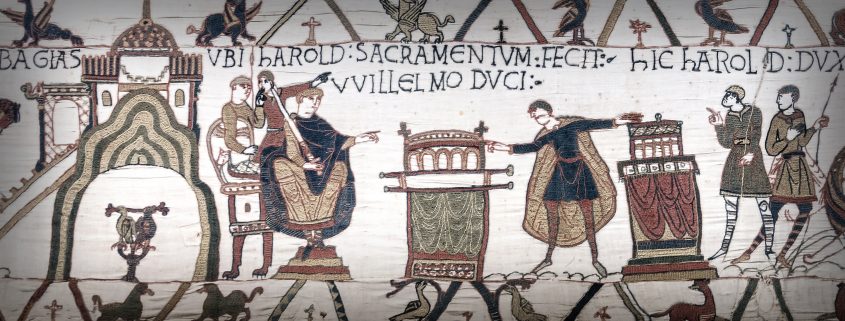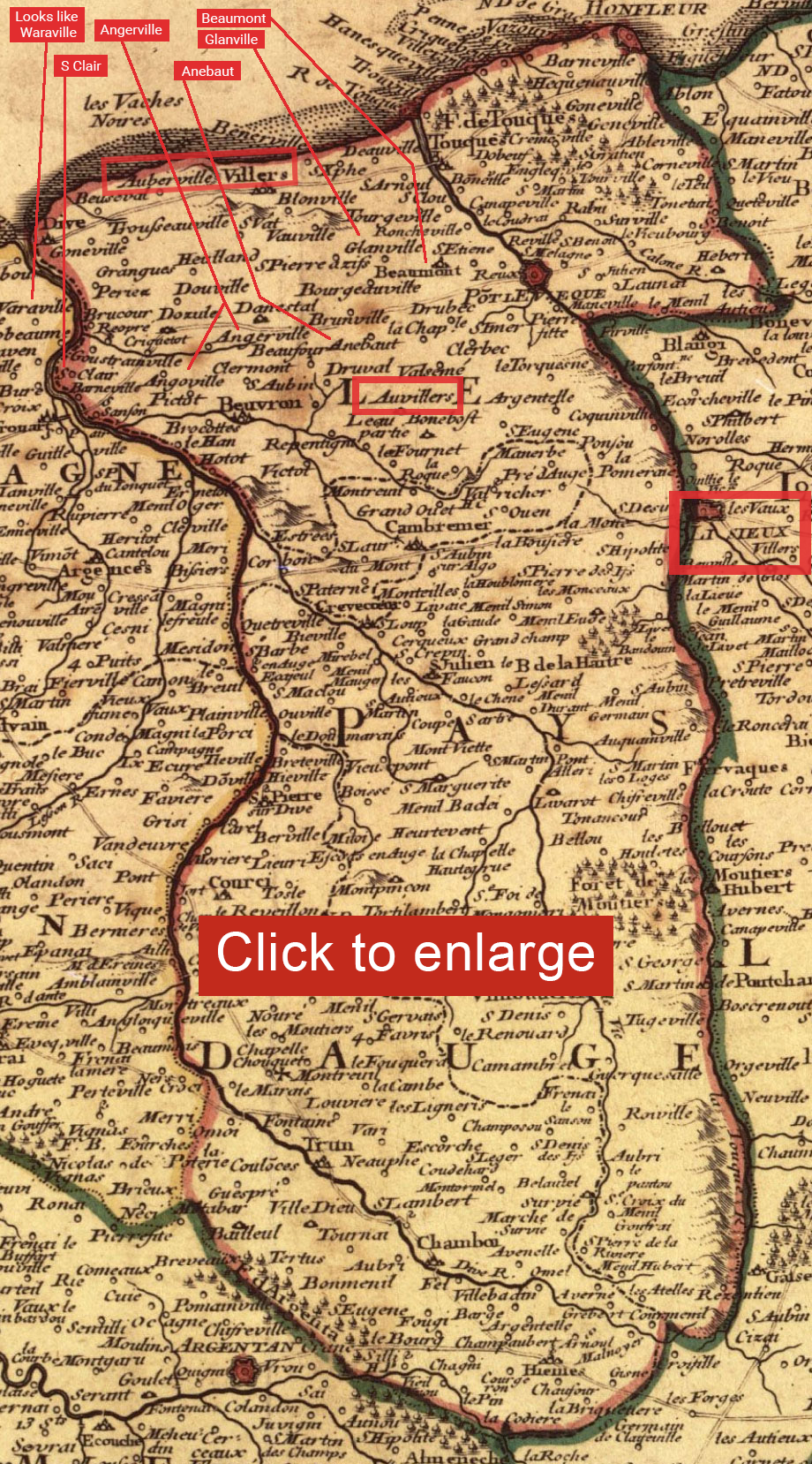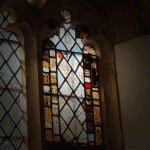
Who’s Who in the Roman de Rou
By Rondo BB Me
In September 2019, Steve St Clair and I undertook a research trip to England during which we traced the footsteps of Bretel St Clair in Somerset, as well as Haimo and William St Clair of Essex. Midway between the two counties, we stopped to see the ruins of William 1 de Warenne – Earl of Surrey and Gundrada’s Priory of St Pancras in East Sussex, a Cluniac house. From there we drove to Battle, the site of the Battle of Hastings in 1066.
We were blessed with exceptionally good weather for the two weeks we did our research, and particularly so as we explored the serene grounds of the ruins of Battle Abbey. Situated on the rise of a high hill, the Abbey was built on the spot where King Harold is purported to have died. The English army held the hill and Duke William and his Norman/Breton/ Flemish troops were forced to advance uphill to engage in battle. As I looked out over the field from the hilltop, I was reminded of the verse in Wace’s Roman de Rou.
Normant a pie e a cheual
Les assaillment comme uassal
Donc poinst Hue de Mortemer,
Od lui li sire d’Auuiler,
Cil d’Onebac e de Saint Cler;
Engleis firent mult enuerser.
Translated to English –
The Normans attacked them
courageously on foot and on horse.
Then Hugh of Mortemer spurred his horse;
he had with him the lord of Auvilliers,
and the lords of Les Oubeaux and of Saint-Clair.
They overthrew many Englishmen. 1
Wace was a Norman poet who chronicled the Dukes of Normandy and the history of Britain. His date of birth was sometime between 1099 and 1111. He was born on the island of Jersey, just off the coast of Normandy and educated in Caen in the Basse-Normandie region. Therefore, Wace would have had contact with those whose parents had been part of the Conquest and his work – such as the Roman de Rou – might be relied upon as a reasonably good resource.
The Normans fought in cohorts under an overlord. In this case, Hugh de Mortemer (in fact it was Ralph de Mortemer – see later) was the overlord of the three knights (or groups of knights) – the lords of Auvillier, Onebac and Saint Cler. As this is the first mention of a Lord of Saint Cler/ Saint-Clair in the literature, it seemed it was important to identify who he may be or, at least, from which of the many places named Saint-Clair he took his name. To this end, each of the four knights was studied, looking for a link and provenance.
Mortemer
Wace named this nobleman as Hue (Hugh) de Mortemer. However, scholars are in agreement that this knight was in fact Hugh’s father, Ranulph/Ralph, the son of Roger de Mortemer, a favourite of Duke William. He was also a close relation of William de Warrene. Both men were richly rewarded with extensive landholdings after Hastings as can be seen in the Domesday Survey of 1086.
The family took its name from their land at Mortemer-sur-Eulne in the arrondisement of Neufchatel in the Seine Maritime of Normandy.
Auvilliers
Adjoining Mortemer is Auvilliers, whose lord was quite probably a military vassal of Ralph de Mortemer. A Hugh d’Aviliers was a tenant of Robert Malet in Suffolk according to the Domesday Book, and was also a benefactor named in the founding charter of Malet’s Priory of Eye.
Onebac
Trying to identify the Lord of Onebac was somewhat more problematic. In 1827, the French editor of the Roman de Rou identified this place as Asnebec, which he claimed was near Vire in the Calvados department of Normandy. The only place I have been able to identify as having been known as Asnebec in medieval times is Saint-Georges-d’Annebecq, some 50km south-east of Vire in the Orne region.3 Its first seigneur was Roger de Beaumont, a close associate of Duke William. For these reasons, I am sceptical of the assertion that this was Onebac.
Instead, I am leaning towards the claim by the Annebaut family that Onebac is one and the same place as the village of Annebaut, 17km north-west of Lisieux, in Calvados in the region named Le Pays d’Auge. As early as the turn of the 10th century it was recorded as Olnebac. Annebaut boasts the vestiges of a feudal moat which can still be seen today. 4, 5
The entry for Annebaut on the website of the Societé Historique de Lisieux states:
La famille des seigneurs d’Annebaut était une des plus anciennes et des plus illustres de la Normandie. On en trouve des membres à la conquête de l’Angleterre en 1066, puis à la suite du duc Robert en Terre-Sainte.
The family of the Lords of Annebaut was one of the most ancient and illustrious in Normandy. Some of its members were at the conquest of England in 1066, then in the train of Duke Robert (Curthose) to the Holy Land. 6
Saint Cler
 The idea that the Saint Cler in Wace was from Saint-Clair-sur-l’Elle never sat easily for me. While researching Annebaut, I found a map of Le Pays d’Auge dated to 1716. While examining it, my attention was caught by a church named Saint-Clair, approximately 7 km to the west of Annebaut. This church was situated on the eastern bank of the river Dives, which flows north and enters the sea at Dives, from which the flotilla of Duke Normandy left for England in 1066.
The idea that the Saint Cler in Wace was from Saint-Clair-sur-l’Elle never sat easily for me. While researching Annebaut, I found a map of Le Pays d’Auge dated to 1716. While examining it, my attention was caught by a church named Saint-Clair, approximately 7 km to the west of Annebaut. This church was situated on the eastern bank of the river Dives, which flows north and enters the sea at Dives, from which the flotilla of Duke Normandy left for England in 1066.
Saint-Clair was held by Robert, Count of Mortain, the half-brother of Duke William. Sometime between 1055 and 1066, Count Robert gave a portion of this domain to the monks at the Abbey of Saint-Pierre at Préaux, which Onfroy de Vieille founded in 1034. It was the site of large fisheries and salt-pans which supplied the salt to preserve the fish caught there, as well as in the sea at Bessin and in the waters of the Risle river at Beaumont-le-Roger. This made it a very lucrative enterprise. In 1080, Duke William, now King of the English, negotiated an exchange of this land for lands in England, returning the alienated land at Saint-Clair to his brother. Interestingly, Count Robert was overlord to Bretel de St Clair in the Domesday Book.
This Saint-Clair was absorbed into nearby Basseneville and became known as Saint-Clair-de-Basseneville. There is a tradition that Mauger, Bishop of Rouen, married a lady from Saint-Clair-de-Basseneville and that their son took the name Saint-Clair. The problems surrounding the two Maugers and their purported connection to the St Clair family is a matter for further research, but I will say now that there is no reason to believe Mauger ever married.
Sources:
1 Project Gutenberg’s The Chronicle of the Norman Conquest, by Master Wace, Produced by Marc D’Hooghe at http://www.freeliterature.org p. 239
2 Rambling in the Orne “Normand Bocage Saint Georges D’Annebecq” http://www.randobocagefertois.fr/decouvertebocageornais-saint-georges-annebecq.html
3 Decouverte Bocage Ornais, Saint Georges D’Annebecq, http://www.randobocagefertois.fr/decouvertebocageornais-saint-georges-annebecq-en.html Découverte Bocage Ornais, Office du tourisme La Ferté-Macé et sa région, 11 rue de La Victoire, 61600,La Ferté-Macé, France Téléphone : 0033 2 33 37 10 97 http://www.decouvertebocageornais.fr
4 Annebault, Wikipedia, https://en.wikipedia.org/wiki/Annebault#References Wikipedia https://en.wikipedia.org/wiki/Annebault
5 Medieval… Remparts de Normandie, LES REMPARTS D’ANNEBAULT , http://remparts-de-normandie.eklablog.com/les-remparts-d-annebault-calvados-a145095016 (Calvados), Par Gilloudifs dans Accueil le 10 Juin 2018 à 18:50
6 Societé Historique de Lisieux, Adigard des Gautries Jean, Lechanteur Fernand. The names of the communes of Normandy – II http://www.societehistoriquedelisieux.fr/?p=5733


